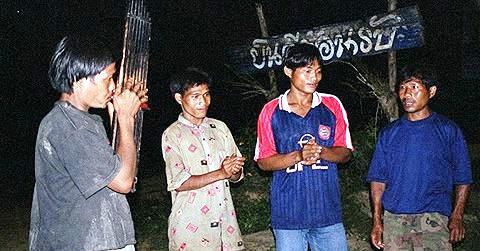| What's Mlabri? |

|
■Research Topic
The purpose of the research project `The Study of the Mlabri ,
an Endangered Language of Northern Thailand` was to study the Mlabri language,
of the Mon-Khumer group, spoken by a small ethnic group in northern Thailand.
Through looking into the people`s use of the language, whether or not there are
dialects, their relations with other ethnic groups, we hoped to gain an understanding
of the Mlabris` overall situation.
■Survey in Thailand
Dates: 1999 (Dec.), 2000 (Feb.), 2001 (Feb., May, Dec)
Place: Huwaihom Village in Rongkwang District of Phrae Prefecture
Total Population: approx 300, 270 to 280 in Thailand, some 20 more in Laos
Settlements: mainly in Phrae and Wiengsa District of Nan Prefecture
Official name of group: Mlabri (used both by themselves and by Thais)
Occupation: contract farm work for Thais and the Hmong (Meo) tribe
About twenty years ago an American missionary started a private assistance project
in Phrae by providing the Mlabri an opportunity to work planting trees and taught
them about earning money by working. People could be assured of steady work and
food, so gradually the Mlabri population in Phrae increased. At present (2001)
there is a settlement of nearly 150. However, people seem to prefer to work for
the Hmong group, probably because they are paid a large sum in advance.
■Population, Settlement, Ascertainment of Mlabri Speakers
In Phrae there are 12 households, a total of 117. An adult from each family was
interviewed to find out about family structure and relationships and a register
compiled. In Aug. 2001 the Mlabri in Phrae were granted citizenship and a census
taken of all residents; this coincided with our research results. The 100+ Mlabri
in Nan still do not have citizenship. The Mlabri in the two prefectures have past
connections and many people are related.
■Dialects
In the past there were at least two Mlabri dialects, but in present day Thailand
only one remains. The vast difference in language spoken by people, even in the
same generation , may reflect different dialects, but this problem was out of the
range of this research.
According to Chazee (2001), the small group of 28 people in present day Laos going
by the name of Yumbri is in fact Mlabri. The Mlabri language taken up by Rischel
(1995) was apparently the same dialect spoken by the Laos group, but it has already
disappeared. Rischel is cautious about the connection between this group, the present
day group in Thailand and the Yumbri language mentioned by Bernatzyk (1938). However,
since Rischel`s Mlabri language no longer exists, linguists regard the language
spoken by known Mlabri groups in Thailand as the very same dialect. It should be
noted that a new group, still unconfirmed, has been discovered in Phrae Prefecture.
■Results of Interviews
Approximately 3000 basic words were compiled and recorded on IPA, digital-voice tapes,
and video tapes. Results of this research showed conspicuous individual differences,
irrespective of age groups. It was apparent that only a few people remembered old words.
There is almost noone who can relate myths or legends. Old customs and traditions are
no longer performed, so we couldn`t gather any material. Phonemes, words, and grammar
all show a strong influence from the Thai language, but characteristics of Mon-Khumer
group are also evident.
■Language Education
Young children speak only Mlabri, then come in contact with standard Thai -speaking
Hmong teachers in kinddergaten, and are educated in standard Thai through 3rd. grade.
Adults are bi-lingual; in addition to standard Thai, many can also speak northern Thai
language, once the common language in the area. There are evening classes in reading
and writing standard Thai. Most men and women up to middle age take part, but only
young people (up to early 20s) become proficient. People over 50 can speak northern
Thai but not standard Thai. Young people talking among themselves switch back and
forth between the two and also listen to standard Thai radio broadcasts.
■Contact with Other Ethnic Groups
Mlabri inter-relations with other groups has changed over the years, but at present
their main contact is with Thais and the Hmong group. There is almost no intermarriage
with other groups. They settle somewhat apart from other etnic groups and make a
living by doing contract work at other groups` farms. The population of Thai farming
villages has decreased, resulting in a shortage of workers, so people from other
ethnic groups are employed. The Hmong tribe is using Mlabri to do heavy work on their
hillside farms. There are even some Hmong people who make a large income without
working themselves, have houses in the lowland, and go into business.It appears that
the Ruwa ? tribe, who have already become lowlanders, once had relations with the Mlabri.
In this region, the common language among people from minority ethnic groups was once
Northern Thai but is now Thai.One matter of concern is that the minority groups in the
north are being used by the tourist industry to attract tourists. Ever since the Mlabri
appeared out of the forest 20 years ago they have been used as a show for tourists.
They are forced to display customs that are not authentic. In 2000 the Mlabri were
granted citizenship and given economic assistance, but what they really need is
sufficient land. This request had not been met.Past contact between Laotians and
northern Thais remains a mystery. Judging from the words we have recorded, the word
groups reflect the history of northern Thai language, from classical Thai down to
northern Thai and standard Thai. It has been thought that these words passed down
to Mlabri through otherminority group languages, but it seems more likely that they
were borrowed directly.
Copyright 2005 SAKAMOTO Hinako All Rights Reserved.
|
